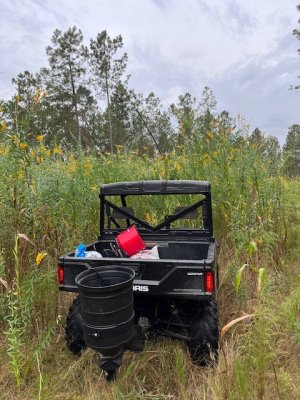SD51555
5 year old buck +
Can you give me a teaser on what that book says about pigweed? It seems like it is prevalent in my food plots no matter the property.
I’ll type up notes in a second.

Sent from my iPhone using Tapatalk
Can you give me a teaser on what that book says about pigweed? It seems like it is prevalent in my food plots no matter the property.


That has been a great combo for me, especially on newly established plots.View attachment 68069
I feel his pain. Sunn Hemp has done well for me. Going to give Alyce clover and Joint vetch a try next spring.
Took delivery yesterday and plowed through most of it!I’ll type up notes in a second.

Sent from my iPhone using Tapatalk
Took delivery yesterday and plowed through most of it!
An I understanding this correctly - if a plant is listed as VL in the Ca column, does that mean it thrives under very low calcium conditions, and that adding calcium may cause it to diminish?
Alas, I need to spend some time with this book.Exactly. Go find your top ten weeds and you’re gonna find your common issue. It’ll jump right off the page.
Sent from my iPhone using Tapatalk
As you might have guessed, my problem plants have VL’s across the board.Exactly. Go find your top ten weeds and you’re gonna find your common issue. It’ll jump right off the page.
Sent from my iPhone using Tapatalk
As you might have guessed, my problem plants have VL’s across the board.
Ca, consistently. Should have said that!What’s your common VL element?
Sent from my iPhone using Tapatalk
Ca, consistently. Should have said that!
Thistles, foxtail, nutsedge, MF rose, common burdock, chickweed, wintercress, and many more.
Have to do some searching for bulk gypsum. Called my local ag fertilizer operation, they reacted as if I'd asked for a load of plutonium. They said they could probably get it but it would be minimum 25 tons, IOW slightly more than I need.
Pulled a soil test on the subject ground just before I planted my first cover crop in 2022.
View attachment 68289
I would be very interested in seeing your “goofy math”!Ok, that’s a good test.
My rough math shows you could go as high as 5,000 lbs gypsum over maybe three years. I’d be cautious about putting too much on at once on a large scale on sandy soil because you can’t pick it up after it’s down.
So I’d break it up over three years, and if u see improvement after the first third, you can pump the breaks before doing a bunch more u may not need.
If u want my goofy math on how I arrived at that, I can share it.
Sent from my iPhone using Tapatalk
Your calcium to magnesium ratio is very close to 4.5:1 (900 ppm to 187 ppm). There is no agreement on the relevancy of Calcium to magnesium ratios. I subscribe to it because when it’s out of whack, it usually presents other management challenges.
You don’t want to go higher than 10:1, so because you’re in sandier soil, let’s shoot for around 7:1 or 8:1. That means you’d have to raise your calcium ppm to around 1500. Gypsum is around 20% calcium. To raise up to 1500 ppm, you’d need 600 ppm Ca, 600 ppm Ca is 1200 lbs.
1200 lbs @ 20% calls for 6,000 lbs/ac gypsum. That’s a lot. Let’s round down to 5,000 and split it into 1/3 each year for 3 years. 1500-1600 lbs/ac is a good shot and I’d want to see what happens for a season. Again, once it’s down, you can’t pick it back up.
Sent from my iPhone using Tapatalk
